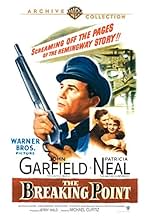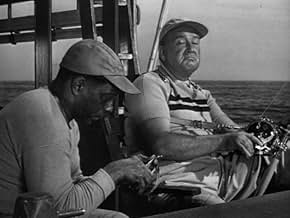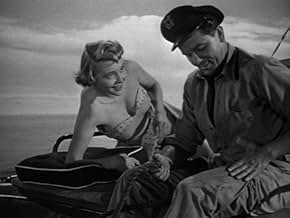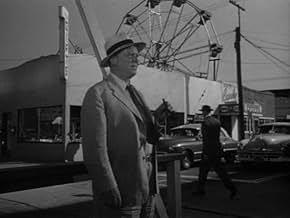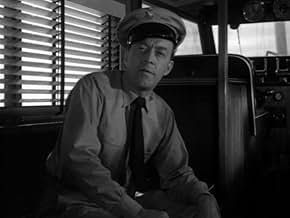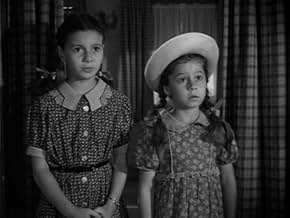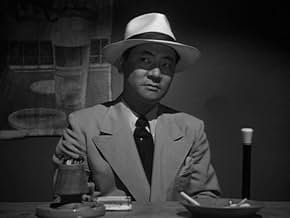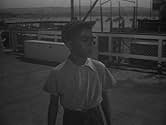IMDb-BEWERTUNG
7,5/10
4968
IHRE BEWERTUNG
Füge eine Handlung in deiner Sprache hinzuAn otherwise moral captain of a charter boat becomes financially strapped and is drawn into illegal activities in order to keep up payments on his boat.An otherwise moral captain of a charter boat becomes financially strapped and is drawn into illegal activities in order to keep up payments on his boat.An otherwise moral captain of a charter boat becomes financially strapped and is drawn into illegal activities in order to keep up payments on his boat.
- Regie
- Drehbuch
- Hauptbesetzung
- Auszeichnungen
- 4 wins total
John Alvin
- Reporter
- (Nicht genannt)
Chet Brandenburg
- Taxi Driver
- (Nicht genannt)
Peter Brocco
- Macho
- (Nicht genannt)
Mary Carroll
- Girl at Bar
- (Nicht genannt)
Spencer Chan
- 1st Chinese Immigrant
- (Nicht genannt)
John Close
- Deputy
- (Nicht genannt)
Empfohlene Bewertungen
Exceptional version of Hemingway's To Have and Have Not is far superior to the Bogart/Bacall film. While the Bogie film was a good picture awash in style and the chemistry of the two leads this is far more realistic without the atmosphere perhaps but loaded with pleasures nonetheless.
For starters this contains one of John Garfield's best performances. Always a fine actor he gets under the skin of his character and makes you understand his desperation and moral conflict, he's riveting every second he is on screen. This was one of his last films before his tragically early death, a sad loss of a great talent who isn't as well remembered as he should be today.
Patricia Neal also scored strongly in this the best of her early roles. She is tough and world weary but also kind and sexy with her whiskey voice and blonde hair. Although it's never stated specifically it's very clear that her character is a prostitute, for the time period a bold point. She and Garfield work very well together and it's a pity his death prevented them from being paired again.
The two other main actors, Phyllis Thaxter and Juano Hernandez, contribute exemplary work as well providing terrific support. Phyllis and Particia Neal are interesting contrasts and their scene together is a study in underplaying. Her scenes with Garfield are also very good, without being explicit they make it clear theirs is a full and happy marriage in all regards with the normal strains and joys.
All this fine work would be for naught if not supported by an excellent screenplay and tight direction from the versatile Curtiz, a man who could direct any genre without problems.
Less romantic in tone but a gripping drama that has been unfortunately obscured by the fame of the other version this is well worth seeking out.
For starters this contains one of John Garfield's best performances. Always a fine actor he gets under the skin of his character and makes you understand his desperation and moral conflict, he's riveting every second he is on screen. This was one of his last films before his tragically early death, a sad loss of a great talent who isn't as well remembered as he should be today.
Patricia Neal also scored strongly in this the best of her early roles. She is tough and world weary but also kind and sexy with her whiskey voice and blonde hair. Although it's never stated specifically it's very clear that her character is a prostitute, for the time period a bold point. She and Garfield work very well together and it's a pity his death prevented them from being paired again.
The two other main actors, Phyllis Thaxter and Juano Hernandez, contribute exemplary work as well providing terrific support. Phyllis and Particia Neal are interesting contrasts and their scene together is a study in underplaying. Her scenes with Garfield are also very good, without being explicit they make it clear theirs is a full and happy marriage in all regards with the normal strains and joys.
All this fine work would be for naught if not supported by an excellent screenplay and tight direction from the versatile Curtiz, a man who could direct any genre without problems.
Less romantic in tone but a gripping drama that has been unfortunately obscured by the fame of the other version this is well worth seeking out.
... He is the same guy as always, struggling against odds, railing about making it, etc., but toned down a bit. He takes umbrage but there is a restraint that is not present in his earlier more angry-young-man roles. Maybe because he looks as little filled out and older and is a family man to boot. There is a relative maturity in the character that is appealing. Despite playing the proverbial "same role" as some actors are thought of as doing, there is no sense that he is phoning it in. And he holds up more effective than ever with the ultimate no-nonsense imperative of tough guys. Tough but regular too, I like the opening sally, i.e., to the effect that when out to sea a certain tranquillity can reign but back on land nothing but trouble. I like that, especially with the ultimate irony to come.
The domestic scenes are not Hemingway, but added for the movie. A wonderful decision. It rounds out Garfield's character giving him a softer side and allows for the domestic sweetness and wholesome prettiness of Phyllis Thaxter to be his wife. I like to feel that her all-to-obvious new hairdo was not lost on her husband and that it might have helped him decide on another matter regarding a certain lady.
Garfield's remark to his 10-year-old daughter about being "too old to run around (the house) like that" (i.e., in night clothes) was a surprising but effective slice-of-life detail that perhaps only in a small way ushers in the new 50s sensibility regarding such matters that will make films more frank and real with youth (teens) issues.
Patricia Neal is stunning as the would-be femme fatale, - would-be because she falls short of treachery. Her worldly manner and sophisticated beauty provides a stark contrast to Garfield's women in the story. She wants to seduce, and pending the outcome, have the goods on him for revenge. Is she too sympathetic for this? Up in the air,,pending definitions. Reliable veteran character actor Wallace Ford has a good gig as a low-level conduit to the underworld. He has good dialogue, pushy and sarcastic with his own clients but totally subservient when around the big boys. A happy addition to the story. The poor boy alone on the pier resonates and is discomforting.
The domestic scenes are not Hemingway, but added for the movie. A wonderful decision. It rounds out Garfield's character giving him a softer side and allows for the domestic sweetness and wholesome prettiness of Phyllis Thaxter to be his wife. I like to feel that her all-to-obvious new hairdo was not lost on her husband and that it might have helped him decide on another matter regarding a certain lady.
Garfield's remark to his 10-year-old daughter about being "too old to run around (the house) like that" (i.e., in night clothes) was a surprising but effective slice-of-life detail that perhaps only in a small way ushers in the new 50s sensibility regarding such matters that will make films more frank and real with youth (teens) issues.
Patricia Neal is stunning as the would-be femme fatale, - would-be because she falls short of treachery. Her worldly manner and sophisticated beauty provides a stark contrast to Garfield's women in the story. She wants to seduce, and pending the outcome, have the goods on him for revenge. Is she too sympathetic for this? Up in the air,,pending definitions. Reliable veteran character actor Wallace Ford has a good gig as a low-level conduit to the underworld. He has good dialogue, pushy and sarcastic with his own clients but totally subservient when around the big boys. A happy addition to the story. The poor boy alone on the pier resonates and is discomforting.
The Breaking Point (1950)
Forget for a second that this is a Hemingway story, or that it was more famously and loosely made into a movie ("To Have and Have Not)" with Bogart and Bacall in 1944.
Here was have John Garfield playing with great realism a boating man, Morgan, who has hit hard times. So he is tempted by an illegal run for some big money. And it goes badly. Then, to get out of that jam, he is drawn into yet another one, which goes even worse.
So this is really a story of a man against the odds. He's basically a good person, which we see in how he treats his partner, his wife, his kids. But it's partly because of those others that he feels he has to come through and make some money. In a way, this is what Hemingway's novel is all about--how a man copes with crisis. (This is always what Hemingway is about, in a way.) It's great starting material.
The two women in the story, made to look slightly similar, are key in a Hemingway kind of way, too, because a Hemingway man is essentially torn by love all his life. Morgan's wife is terrific in a simple, unexciting way, and when Patricia Neal appears very sexually hungry, Morgan at first is not interested. Neal's character is not quite a noir femme fatale, since she really wants nothing for herself, but is a distraction and siren.
The two of them are terrific. Around them are a whole swarm of characters, some with important roles and excellent character actors, but we really get inside the head of Garfield and we really feel the weirdly brazen and carefree intensity of Neal.
So why is this a forgotten film? For one, Garfield is a low key leading man. He always is. His effect is subtle. And Neal isn't a steaming hottie or an outrageous caricature like some leading (blonde) women in these crime films. And then, frankly, they don't totally have chemistry on screen, which is neither one's fault alone, and which isn't so inaccurate to the story.
And about Hemingway? The book is great. You have to like his style and his manly view, but if you can adapt to that, read it. Easy reading, too. And he set the scene in the waters between Florida and Cuba, which is where he lived and fished. The Bogart version was set in the war, working for the French Resistance in Europe. The Garfield version was set (and shot) in California, with a trip to Mexico. A later version (1958) is set in Florida.
This is actually a first rate movie. Part of the success depends on the writing-both Hemingway and the sharp, noir-influenced screenplay by Ranald MacDougall. Note that the photography is by the great Ted McCord (Sound of Music, East of Eden, etc.).
The plot has some deeply personal aspects, both with Morgan's wife and kids as they barely scrape by and with the temptation of the sort of femme fatale played with a cool sharpness by Patricia Neal. And it has a serious crime plot with several angles that develop and disperse and develop further. It moves from dark night scenes to open water scenes to a faked fog ending (a flaw, visually, because you can tell it's just been processed for lower contrast even though the sun is out).
The movie also has some aspects that strike me as socially relevant, starting with the smuggling of a group of Chinese people out of Mexico at the start and ending with the tragic dilemma of a little African-American boy left literally alone on a big open dock at the final fade. This last aspect (which I can't get specific about without spoiling something) points to one of the really big interpersonal parts of the film that is key, and that I wish had been developed just a hair more because it's so key.
On my third viewing, I continue to like it a lot. See it.
Forget for a second that this is a Hemingway story, or that it was more famously and loosely made into a movie ("To Have and Have Not)" with Bogart and Bacall in 1944.
Here was have John Garfield playing with great realism a boating man, Morgan, who has hit hard times. So he is tempted by an illegal run for some big money. And it goes badly. Then, to get out of that jam, he is drawn into yet another one, which goes even worse.
So this is really a story of a man against the odds. He's basically a good person, which we see in how he treats his partner, his wife, his kids. But it's partly because of those others that he feels he has to come through and make some money. In a way, this is what Hemingway's novel is all about--how a man copes with crisis. (This is always what Hemingway is about, in a way.) It's great starting material.
The two women in the story, made to look slightly similar, are key in a Hemingway kind of way, too, because a Hemingway man is essentially torn by love all his life. Morgan's wife is terrific in a simple, unexciting way, and when Patricia Neal appears very sexually hungry, Morgan at first is not interested. Neal's character is not quite a noir femme fatale, since she really wants nothing for herself, but is a distraction and siren.
The two of them are terrific. Around them are a whole swarm of characters, some with important roles and excellent character actors, but we really get inside the head of Garfield and we really feel the weirdly brazen and carefree intensity of Neal.
So why is this a forgotten film? For one, Garfield is a low key leading man. He always is. His effect is subtle. And Neal isn't a steaming hottie or an outrageous caricature like some leading (blonde) women in these crime films. And then, frankly, they don't totally have chemistry on screen, which is neither one's fault alone, and which isn't so inaccurate to the story.
And about Hemingway? The book is great. You have to like his style and his manly view, but if you can adapt to that, read it. Easy reading, too. And he set the scene in the waters between Florida and Cuba, which is where he lived and fished. The Bogart version was set in the war, working for the French Resistance in Europe. The Garfield version was set (and shot) in California, with a trip to Mexico. A later version (1958) is set in Florida.
This is actually a first rate movie. Part of the success depends on the writing-both Hemingway and the sharp, noir-influenced screenplay by Ranald MacDougall. Note that the photography is by the great Ted McCord (Sound of Music, East of Eden, etc.).
The plot has some deeply personal aspects, both with Morgan's wife and kids as they barely scrape by and with the temptation of the sort of femme fatale played with a cool sharpness by Patricia Neal. And it has a serious crime plot with several angles that develop and disperse and develop further. It moves from dark night scenes to open water scenes to a faked fog ending (a flaw, visually, because you can tell it's just been processed for lower contrast even though the sun is out).
The movie also has some aspects that strike me as socially relevant, starting with the smuggling of a group of Chinese people out of Mexico at the start and ending with the tragic dilemma of a little African-American boy left literally alone on a big open dock at the final fade. This last aspect (which I can't get specific about without spoiling something) points to one of the really big interpersonal parts of the film that is key, and that I wish had been developed just a hair more because it's so key.
On my third viewing, I continue to like it a lot. See it.
An underrated flick in the Garfield canon. His charter boat captain, Morgan, may not be very likable, but the actor makes him a compelling tough guy. So, how's Morgan going to pay his debts and keep his charter boat. It's a struggle, especially when wheedling deal-maker Duncan (Ford) keeps tempting him with illegal transporting. It's really a battle for Morgan's soul though he doesn't realize it. On one hand there's faithful wife Lucy (Thaxter) and two small daughters, along with deck hand Park (Hernandez) depending on him for support. On the other, is smoothy Duncan, sultry temptress Leona (Neal), and an array of criminal types offering him money for illegal services. Trouble is Morgan loves both Lucy and his boat, so will he stay honest and get a new livelihood, or will he succumb to seductive overtures from Duncan and turn criminal boat captain.
Garfield's Morgan is not a nice guy, so the outcome is uncertain. Every other word is a smart-alecky remark, and though he loves wife Lucy and the two little girls, he seems to forget them when obsessing about his boat. Clearly, his ego is tied up with being a captain.
It's a perfect Garfield role, and he gives no quarter. At the same time, Thaxter works wonders as the sympathetic wife without getting smarmy, a really difficult role. And shouldn't overlook Neal whose grinning blonde temptress resembles a figure from perhaps the lower regions. Then too, inclusion of Black actor Hernandez was a bold one for 1950 when Black actors were still mostly servants or comic relief. Moreover, his inclusion results indirectly in one of the most brilliantly poignant final scenes in film annals. I get the feeling the writers were doing their best to avoid a typical Hollywood ending, which was still the norm.
All in all, the movie deserves a ranking just below Garfield's celebrated Force of Evil (1948) as a study in self-realization. Please, TCM, revive the flick whenever you can.
Garfield's Morgan is not a nice guy, so the outcome is uncertain. Every other word is a smart-alecky remark, and though he loves wife Lucy and the two little girls, he seems to forget them when obsessing about his boat. Clearly, his ego is tied up with being a captain.
It's a perfect Garfield role, and he gives no quarter. At the same time, Thaxter works wonders as the sympathetic wife without getting smarmy, a really difficult role. And shouldn't overlook Neal whose grinning blonde temptress resembles a figure from perhaps the lower regions. Then too, inclusion of Black actor Hernandez was a bold one for 1950 when Black actors were still mostly servants or comic relief. Moreover, his inclusion results indirectly in one of the most brilliantly poignant final scenes in film annals. I get the feeling the writers were doing their best to avoid a typical Hollywood ending, which was still the norm.
All in all, the movie deserves a ranking just below Garfield's celebrated Force of Evil (1948) as a study in self-realization. Please, TCM, revive the flick whenever you can.
With the Depression, the so-called "upper class," the subject of so many plays and films, began to fade and be replaced by the work of playwrights such as Clifford Odets.
John Garfield was the type of leading man who came out of that kind of working man play -- more rugged than romantic, more blue collar than white collar, more at home in a leather jacket than a tuxedo. That leading man type would peak post-war with the likes of Dean, Brando, Steiger, Newman, McQueen, and others. But their predecessor was John Garfield.
Here he stars in his second-last film, as he would soon be blacklisted -- it's "The Breaking Point," based on the Hemingway novel "To Have and Have Not," but not really like the Bogart-Bacall film, which borrowed the title.
In "The Breaking Point," Garfield plays Harry Morgan, who runs a charter boat in California. He has a wife, Lucy (Phyllis Thaxter) and two daughters (Sherry Jackson, Donna Jo Boyce). Times are tough (the original novel took place during the Depression) and Harry is having trouble making enough money to pay off his boat and raise his family.
Lucy wishes her husband would work for his father on his lettuce farm in Salinas, but Harry says all he knows is boats.
Because he needs money, Harry agrees to carry out a shady deal, transporting Chinese to the United States. But when he is cheated out of most of his money, he returns the men where he picked them up. However, someone rats on him and he nearly loses his boat.
When the boat's owner threatens to take the boat for nonpayment, Harry agrees to another shady deal; this one proves more dangerous.
Very intense film which also stars Juano Hernandez, who was wonderful in so many films until his death in 1970; Patricia Neal in her "babe" days, as a former boat passenger who is attracted to Harry; and Wallace Ford, as a foolish man involved in nefarious schemes. William Campbell, whose big claim to fame was that he was married to JFK's girlfriend Judith Exton, plays a low-level criminal.
John Garfield gives a brilliant performance as a stubborn, intense, desperate man who doesn't know where to turn. His last movie, He Ran All the Way, was a B movie and a clear indication that, thanks to the Communist witch hunt, he was on his way out. He died two years later.
Beautifully directed by Michael Curtiz, the end of the movie is especially poignant.
John Garfield was the type of leading man who came out of that kind of working man play -- more rugged than romantic, more blue collar than white collar, more at home in a leather jacket than a tuxedo. That leading man type would peak post-war with the likes of Dean, Brando, Steiger, Newman, McQueen, and others. But their predecessor was John Garfield.
Here he stars in his second-last film, as he would soon be blacklisted -- it's "The Breaking Point," based on the Hemingway novel "To Have and Have Not," but not really like the Bogart-Bacall film, which borrowed the title.
In "The Breaking Point," Garfield plays Harry Morgan, who runs a charter boat in California. He has a wife, Lucy (Phyllis Thaxter) and two daughters (Sherry Jackson, Donna Jo Boyce). Times are tough (the original novel took place during the Depression) and Harry is having trouble making enough money to pay off his boat and raise his family.
Lucy wishes her husband would work for his father on his lettuce farm in Salinas, but Harry says all he knows is boats.
Because he needs money, Harry agrees to carry out a shady deal, transporting Chinese to the United States. But when he is cheated out of most of his money, he returns the men where he picked them up. However, someone rats on him and he nearly loses his boat.
When the boat's owner threatens to take the boat for nonpayment, Harry agrees to another shady deal; this one proves more dangerous.
Very intense film which also stars Juano Hernandez, who was wonderful in so many films until his death in 1970; Patricia Neal in her "babe" days, as a former boat passenger who is attracted to Harry; and Wallace Ford, as a foolish man involved in nefarious schemes. William Campbell, whose big claim to fame was that he was married to JFK's girlfriend Judith Exton, plays a low-level criminal.
John Garfield gives a brilliant performance as a stubborn, intense, desperate man who doesn't know where to turn. His last movie, He Ran All the Way, was a B movie and a clear indication that, thanks to the Communist witch hunt, he was on his way out. He died two years later.
Beautifully directed by Michael Curtiz, the end of the movie is especially poignant.
Wusstest du schon
- WissenswertesAccording to TCM's Eddie Muller, John Garfield thought this was his best performance and that it was the film of which he was most proud.
- PatzerWhen she first steps onto the boat, Patricia Neal's voice is heard saying "we're off to sunny Mexico," but her lips aren't moving.
- Zitate
Harry Morgan: You know, my wife dyed her hair.
Leona Charles: Coincidentally I've been thinking of letting mine grow out. Speaking of coincidences, I live in Number Seven. My friends just kick the door open.
- Crazy CreditsTHE END close out. All lettering aligned and centered except for the line beneath Warner Bros. that begins PICTURES. It's left registered with whatever wording that followed it 'air brushed' over using the lower right drop shadow pattern leaving a Warner Bros. Pictures _?_?_?_?_ mystery.
- VerbindungenFeatured in The John Garfield Story (2003)
- SoundtracksPlease Don't Talk About Me When I'm Gone
(uncredited)
Music by Sam H. Stept
Lyrics by Sidney Clare
Sung by Patricia Neal in the bar
Top-Auswahl
Melde dich zum Bewerten an und greife auf die Watchlist für personalisierte Empfehlungen zu.
- How long is The Breaking Point?Powered by Alexa
Details
- Laufzeit
- 1 Std. 37 Min.(97 min)
- Farbe
- Seitenverhältnis
- 1.33 : 1
Zu dieser Seite beitragen
Bearbeitung vorschlagen oder fehlenden Inhalt hinzufügen



